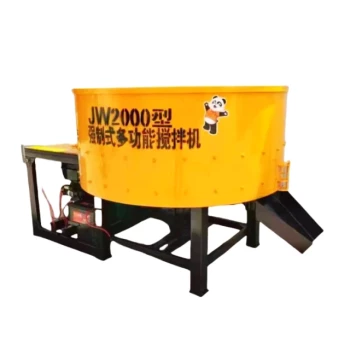The proper sequence for loading materials into a cement mixer involves a balance of wet and dry components to ensure even mixing and optimal consistency. Starting with half the water helps coat aggregates like gravel, followed by cement and sand for a smooth blend. The remaining water is added gradually to achieve the desired texture, while avoiding overloading the mixer. This method prevents clumping, ensures homogeneity, and maximizes efficiency.
Key Points Explained:
-
Initial Water Addition (50% of Total Water)
- Adding half the water first helps wet the mixer drum and pre-coat aggregates (e.g., gravel or crushed stone).
- This reduces dust and ensures aggregates are evenly saturated, preventing dry pockets in the final mix.
-
Aggregates Introduction
- Gravel or coarse aggregates are added next to leverage the pre-wetting effect.
- Coating aggregates early prevents cement from sticking to the drum or forming clumps.
-
Cement Application
- Cement is added after aggregates to distribute it evenly across the wet surfaces.
- This step minimizes waste and ensures a consistent bond between cement and aggregates.
-
Sand Incorporation
- Sand is introduced to fill voids between larger aggregates and cement particles.
- It acts as a lubricant, improving workability and reducing friction during mixing.
-
Gradual Water Completion
- The remaining water is added incrementally to adjust consistency.
- Over-pouring can weaken the mix, so careful monitoring is essential.
-
Mixing in Batches
- Avoid exceeding the mixer’s capacity to ensure thorough blending.
- Partial loads allow better movement of materials inside the drum.
-
Final Mixing & Discharge
- A steady mixing regime (typically 3-5 minutes) ensures homogeneity.
- Discharge promptly to prevent setting or segregation of materials.
Practical Considerations:
- Equipment Limits: Always adhere to the manufacturer’s load guidelines to avoid mechanical strain.
- Additives: If using admixtures (e.g., accelerators), introduce them with the final water phase.
- Dry Mixing Alternative: Some protocols start with dry aggregates and cement, then add water—useful for precise moisture control.
By following this sequence, you optimize both mixer performance and concrete quality, whether for small DIY projects or large-scale construction. Have you considered how slight variations in water timing might affect curing strength?
Summary Table:
| Step | Action | Purpose |
|---|---|---|
| 1. Initial Water | Add 50% of total water first. | Pre-wets aggregates, reduces dust, and prevents dry pockets. |
| 2. Aggregates | Introduce gravel or coarse aggregates. | Leverages pre-wetting for even cement distribution. |
| 3. Cement | Apply cement over wet aggregates. | Ensures consistent bonding and minimizes waste. |
| 4. Sand | Add sand to fill voids between aggregates and cement. | Improves workability and reduces friction. |
| 5. Final Water | Gradually pour remaining water to adjust consistency. | Prevents over-dilution and weak mixes. |
| 6. Mixing | Blend for 3-5 minutes without overloading. | Achieves homogeneity and prevents segregation. |
| 7. Discharge | Empty mixer promptly. | Avoids premature setting or material separation. |
Need a reliable cement mixer for your construction projects?
At GARLWAY, we specialize in high-performance construction machinery, including durable cement mixers designed for efficiency and longevity. Whether you're a contractor or managing large-scale builds, our equipment ensures consistent, high-quality concrete mixes every time.
Contact our team today to find the perfect mixer for your needs!
Related Products
- HZS75 Concrete Batching Plant Cement Mixer Price Concrete Mixer Bunnings Mixing Plant
- JZC1000 Industrial Concrete Mixer Machine Cement Mixer Price
- Concrete Cement Mixer Machine Drum Mixer for Construction
- Auto Concrete Cement Mixer Machine New
- HZS25 Best Cement Mixer for Quick Mix Concrete at Bunnings
People Also Ask
- Can you mix self leveling concrete in a cement mixer? Why Specialized Equipment Matters
- Can you mix mortar in a cement mixer? Pros, Cons & Best Practices
- How do I choose a cement mixer? Find the Perfect Mix for Your Project
- How much does a batching plant cost? Pricing Guide for Concrete Mixing Plants
- How to start a concrete plant business? A Step-by-Step Guide to Building Your Construction Materials Venture



















